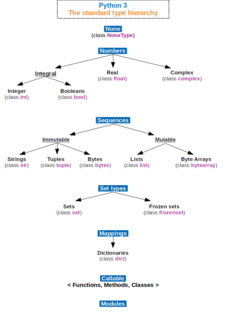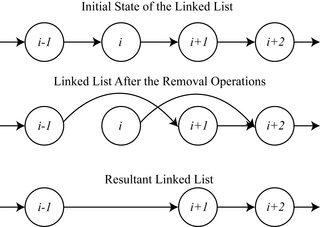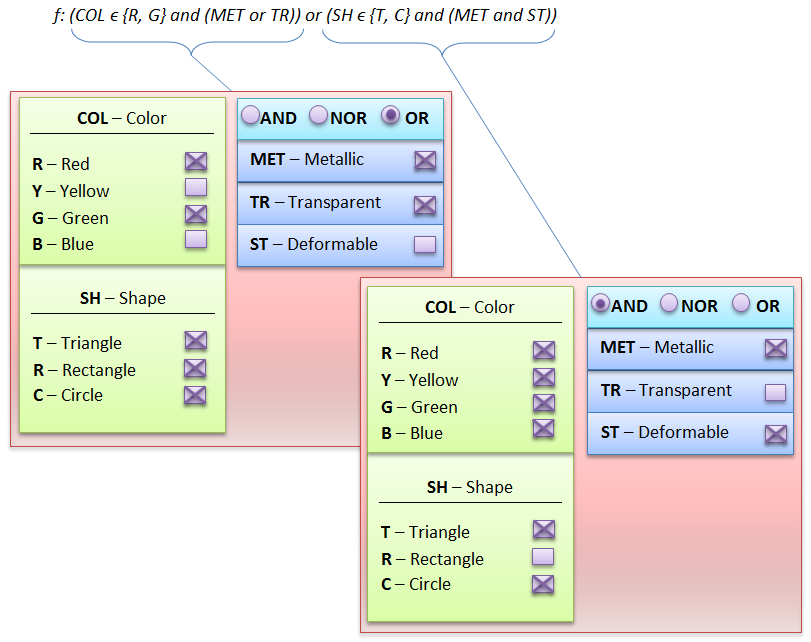
In abstract algebra, a Boolean algebra or Boolean lattice is a complemented distributive lattice. This type of algebraic structure captures essential properties of both set operations and logic operations. A Boolean algebra can be seen as a generalization of a power set algebra or a field of sets, or its elements can be viewed as generalized truth values. It is also a special case of a De Morgan algebra and a Kleene algebra.
A relational database is a digital database based on the relational model of data, as proposed by E. F. Codd in 1970.
A software system used to maintain relational databases is a relational database management system (RDBMS). Virtually all relational database systems use SQL for querying and maintaining the database.

The relational model (RM) for database management is an approach to managing data using a structure and language consistent with first-order predicate logic, first described in 1969 by English computer scientist Edgar F. Codd, where all data is represented in terms of tuples, grouped into relations. A database organized in terms of the relational model is a relational database.

In computer science and computer programming, a data type or simply type is an attribute of data which tells the compiler or interpreter how the programmer intends to use the data. Most programming languages support common data types of real, integer and boolean. A data type constrains the values that an expression, such as a variable or a function, might take. This data type defines the operations that can be done on the data, the meaning of the data, and the way values of that type can be stored. A type of value from which an expression may take its value.
Constraint satisfaction problems (CSPs) are mathematical questions defined as a set of objects whose state must satisfy a number of constraints or limitations. CSPs represent the entities in a problem as a homogeneous collection of finite constraints over variables, which is solved by constraint satisfaction methods. CSPs are the subject of intense research in both artificial intelligence and operations research, since the regularity in their formulation provides a common basis to analyze and solve problems of many seemingly unrelated families. CSPs often exhibit high complexity, requiring a combination of heuristics and combinatorial search methods to be solved in a reasonable time. The Boolean satisfiability problem (SAT), the satisfiability modulo theories (SMT) and answer set programming (ASP) can be roughly thought of as certain forms of the constraint satisfaction problem.
Backtracking is a general algorithm for finding all solutions to some computational problems, notably constraint satisfaction problems, that incrementally builds candidates to the solutions, and abandons a candidate ("backtracks") as soon as it determines that the candidate cannot possibly be completed to a valid solution.

Solid modeling is a consistent set of principles for mathematical and computer modeling of three-dimensional solids. Solid modeling is distinguished from related areas of geometric modeling and computer graphics by its emphasis on physical fidelity. Together, the principles of geometric and solid modeling form the foundation of 3D-computer-aided design and in general support the creation, exchange, visualization, animation, interrogation, and annotation of digital models of physical objects.
A virtual finite state machine (VFSM) is a finite state machine (FSM) defined in a Virtual Environment. The VFSM concept provides a software specification method to describe the behaviour of a control system using assigned names of input control properties and of output actions.
In machine learning and pattern recognition, a feature is an individual measurable property or characteristic of a phenomenon being observed. Choosing informative, discriminating and independent features is a crucial step for effective algorithms in pattern recognition, classification and regression. Features are usually numeric, but structural features such as strings and graphs are used in syntactic pattern recognition.
The concept of "feature" is related to that of explanatory variable used in statistical techniques such as linear regression.
In mathematical logic, a Boolean-valued model is a generalization of the ordinary Tarskian notion of structure from model theory. In a Boolean-valued model, the truth values of propositions are not limited to "true" and "false", but instead take values in some fixed complete Boolean algebra.
Configurators, also known as choice boards, design systems, toolkits, or co-design platforms, are responsible for guiding the user through the configuration process. Different variations are represented, visualized, assessed and priced which starts a learning-by-doing process for the user. While the term “configurator” or “configuration system” is quoted rather often in literature, it is used for the most part in a technical sense addressing a software tool. The success of such an interaction system is, however, not only defined by its technological capabilities, but also by its integration in the whole sale environment, its ability to allow for learning by doing, to provide experience and process satisfaction, and its integration into the brand concept.

EXPRESS is a standard data modeling language for product data. EXPRESS is formalized in the ISO Standard for the Exchange of Product model STEP, and standardized as ISO 10303-11.

XYplorer is a file manager for Windows XP, Vista, 7, 8, and 10. XYplorer is a hybrid file manager that combines features found in navigational and orthodox file managers. In addition to dual folder panes it features a file tree and a tabbed interface supporting drag-and-drop between tabs and panes. The program is available in a fully featured trialware version as well as a feature-limited freeware version.
In software development, a feature model is a compact representation of all the products of the Software Product Line (SPL) in terms of "features". Feature models are visually represented by means of feature diagrams. Feature models are widely used during the whole product line development process and are commonly used as input to produce other assets such as documents, architecture definition, or pieces of code.
Knowledge-based configuration, or also referred to as product configuration or product customization, is an activity of customising a product to meet the needs of a particular customer. The product in question may consist of mechanical parts, services, and software. Knowledge-based configuration is a major application area for artificial intelligence (AI), and it is based on modelling of the configurations in a manner that allows the utilisation of AI techniques for searching for a valid configuration to meet the needs of a particular customer.
OptimJ is an extension of the Java with language support for writing optimization models and abstractions for bulk data processing. The extensions and the proprietary product implementing the extensions were developed by Ateji which went out of business in September 2011.
OptimJ aims at providing a clear and concise algebraic notation for optimization modeling, removing compatibility barriers between optimization modeling and application programming tools, and bringing software engineering techniques such as object-orientation and modern IDE support to optimization experts.
JSON-WSP is a web-service protocol that uses JSON for service description, requests and responses. It is inspired from JSON-RPC, but the lack of a service description specification with documentation in JSON-RPC sparked the design of JSON-WSP.

The composition of a product can be represented using a directed acyclic graph, called real structure, in which every node is an aggregation of its children nodes:
In mathematics and mathematical logic, Boolean algebra is the branch of algebra in which the values of the variables are the truth values true and false, usually denoted 1 and 0 respectively. Instead of elementary algebra where the values of the variables are numbers, and the prime operations are addition and multiplication, the main operations of Boolean algebra are the conjunction and denoted as ∧, the disjunction or denoted as ∨, and the negation not denoted as ¬. It is thus a formalism for describing logical relations in the same way that elementary algebra describes numeric relations.











